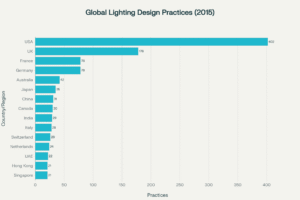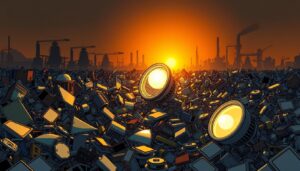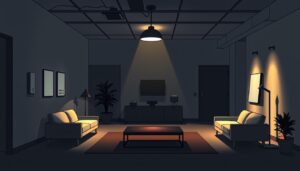According to CIBSE’s LG14 guide, modern lighting systems are no longer just about flipping a switch—they are smart, energy-saving solutions that help businesses meet sustainability goals and cut costs.
Modern lighting control goes far beyond basic on/off switches. It’s about managing illumination intelligently — delivering the right light, in the right place, at the right time. Whether you’re designing a new workspace or upgrading an existing one, understanding control systems can help you achieve real, measurable energy savings.
This guide compares mains dimmable, DALI, and Casambi wireless control systems — explaining how each works, where they’re best used, and how they can help meet efficiency and compliance goals.
All Lumenloop luminaires are available with any of these control options, configured to suit your project requirements.
What Energy-Efficient Lighting Control Really Means
Energy-efficient lighting control isn’t just a buzzword — it’s a design approach that helps buildings cut waste while improving comfort. According to Part L Building Regulations, lighting systems must automatically reduce power when natural light is available or when spaces are unoccupied.
Common control strategies:
Occupancy detection: Lights turn off automatically when areas are empty.
Daylight harvesting: Output adjusts based on available daylight.
Time scheduling: Lights follow predefined operating hours.
Scene control: Preset lighting levels for meetings, tasks, or ambience.
Combining these strategies typically reduces lighting energy use by 30–60%, while extending component life and maintaining visual comfort.
Comparing the Main Lighting Control Systems
Each control method communicates with luminaires differently, offering distinct levels of flexibility and sophistication. The right choice depends on the size of your project, type of space, and desired functionality.
| Control Type | Communication | Flexibility | Typical Use | Key Advantages | Limitations |
|---|---|---|---|---|---|
| Mains dimmable | Phase-cut via mains voltage | Low | Retail, small offices, residential | Simple, affordable, widely compatible | No digital feedback or automation |
| DALI | Wired digital bus | Medium | Commercial, education, healthcare | Reliable, addressable, scalable | Requires additional wiring and setup |
| Casambi | Wireless Bluetooth mesh | High | Retrofits, architectural and smart offices | No control wiring, app-based flexibility | Slightly higher initial configuration cost |
Casambi Lighting Control: Wireless Flexibility for Modern Spaces
Casambi uses Bluetooth Low Energy to form a mesh network where each luminaire, sensor, and switch communicates seamlessly.
No central controller or wiring network is needed, making it ideal for both new and retrofit projects.
Key benefits include:
App-based control via smartphone or tablet
Instant scene creation and grouping
Scalable from a single room to an entire building
Automatic daylight and occupancy responses
Casambi’s flexibility also allows integration with wired systems and third-party sensors. If you’re specifying architectural or heritage spaces, this wireless approach often reduces disruption and installation time.
You can also explore Casambi-compatible Lumenloop products.
DALI Lighting Protocol: The Commercial Benchmark
The DALI protocol (Digital Addressable Lighting Interface) is the global standard for wired lighting control. Each luminaire or driver has its own address, allowing you to control individual fittings or entire zones from a central interface.
Why DALI works so well in commercial spaces:
Two-way communication — luminaires send performance and failure feedback
Precise control — ideal for open-plan offices and classrooms
Integration with Building Management Systems (BMS)
Supports emergency lighting test reporting
DALI installations are exceptionally reliable for large-scale applications that require consistency, such as schools, healthcare environments, or modern offices.
Compare systems in DALI vs Casambi: Choosing the Right Control System.
| Feature | DALI | Casambi |
|---|---|---|
| Connection Type | Wired (bus cable) | Wireless (Bluetooth mesh) |
| Integration with BMS | Yes | Limited (via gateway) |
| Retrofit Suitability | Moderate | Excellent |
| Setup Complexity | Medium | Low |
| Mobile App Control | No | Yes |
Mains Dimmable Lighting: Simple and Cost-Effective
Mains dimmable control uses a traditional phase-cut method to adjust brightness by altering the power waveform. It’s common in smaller projects and simple enough for most electricians to install without specialist programming.
Advantages:
Low cost and easy setup
Compatible with existing wiring
Reliable for basic dimming needs
Limitations:
No feedback or automation
Potential flicker if incompatible dimmers are used
Not ideal for large-scale or sensor-controlled environments
For small offices, showrooms, or residential conversions, mains dimming can still offer efficient control when paired with LED luminaires designed for phase-cut drivers.
Choosing the Right Control System
Selecting a lighting control system depends on project scope, control objectives, and installation constraints.
Here’s a quick guide:
| Project Type | Recommended Control | Why It Works |
|---|---|---|
| Retrofit / heritage building | Casambi | No wiring, quick setup, minimal disruption |
| New commercial build | DALI | Integrates with emergency and BMS systems |
| Small office or retail | Mains dimmable | Simple and affordable manual dimming |
Every Lumenloop luminaire can be configured for Casambi, DALI, or mains dimmable operation — giving you total flexibility at specification stage.
You can also combine systems in one project for hybrid installations (for example, DALI in work zones and Casambi for meeting rooms).
How Lighting Control Boosts Energy Savings and Compliance
Lighting typically accounts for up to 40% of a building’s electricity use.
Intelligent control can halve that figure by dimming or switching off luminaires when not needed.
| Control Method | Approx. Energy Savings | Additional Benefit |
|---|---|---|
| Occupancy sensing | 25–40% | Ideal for corridors and meeting rooms |
| Daylight dimming | 20–35% | Balances natural and artificial light |
| Time scheduling | 10–20% | Matches lighting use to building occupancy |
Future Trends in Lighting Control
The boundary between wired and wireless systems continues to blur.
DALI-2 now includes advanced data feedback from sensors, while Casambi continues to evolve with third-party integrations and cloud management options. Both systems support adaptive, human-centric lighting strategies for wellbeing-focused environments.
Lumenloop integrates these technologies directly into our UK-made luminaires, designed for modular upgrades, circular reuse, and long-term serviceability.
Final Thoughts
Energy-efficient lighting control is one of the simplest ways to lower running costs and carbon emissions while improving user comfort.
Whether you prefer the simplicity of mains dimming, the proven reliability of DALI, or the freedom of Casambi, the key is matching the control type to your building’s needs.
All Lumenloop luminaires are made to order and available with any control option. Our team can help specify the best drivers, sensors, and accessories to suit your project — from offices and retail to industrial and architectural environments.
Get in touch with Lumenloop to discuss your lighting control requirements.












